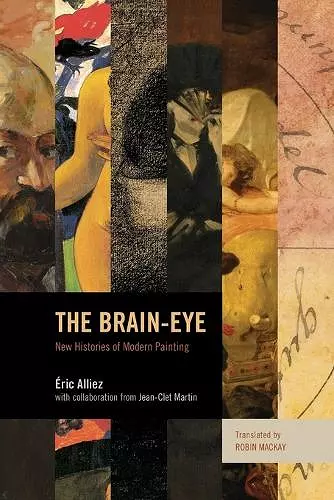The Brain-Eye
New Histories of Modern Painting
Eric Alliez author Jean-Clet Martin author Robin Mackay translator
Format:Paperback
Publisher:Rowman & Littlefield International
Published:11th Dec '15
Currently unavailable, and unfortunately no date known when it will be back
This paperback is available in another edition too:
- Hardback£152.00(9781783480678)

A detailed and inventive study of the thinking at work in modern painting, drawing on a formidable body of scholarly evidence to challenge modernist and phenomenological readings of art history, The Brain-Eye presents a series of interlinked ‘case studies’ in which philosophical thought encounters the hallucinatory sensations unleashed by ‘painter-researchers.’ Rather than outlining a new ‘philosophy of art,’ The Brain-Eye details the singular problems pursued by each of its protagonists. Striking readings of the oeuvres of Delacroix, Seurat, Manet, Gauguin, and Cézanne recount the plural histories of artists who worked to free the differential forces of colour, discovered by Goethe in his Colour Theory, in the name of a “true hallucination” and of a logic proper to the Visual. A rigorous renewal of the philosophical thinking of visual art, The Brain-Eye explores the complex relations between concept and sensation, theory and practice, the discursive and the visual, and draws out the political and philosophical stakes of the aesthetic revolution in modern painting.
This amazingly erudite, visually sensitive, and philosophically innovative, post-phenomenological study offers multiple, rich perspectives on thinking in and through painting, as it interrogates five paradigmatic pathbreaking artists from Delacroix to Cezanne. Deploying innovative concepts of hallucination and the brain-eye, Alliez convincingly revises our thinking about color, atmosphere, diagram, seriality, and artists' ways of working. -- Gary Shapiro, Tucker-Boatwright Professor in the Humanities-Philosophy, University of Richmond
Eric Alliez proposes a consummately erudite journey through modern painting, asking at each step of the way one crucial question: how does painting think? Not: how can we think the painting as a visual object? But rather: what force of thought moves through painting itself to constitute the visual, anterior to the objectivity of the painting as to the subjectivity of the viewer? The answer is kaleidoscopic: an adventure in philosophy through the vicissitudes of color. A major contribution to philosophy in its relation to art history and visual studies. -- Brian Massumi, Professor of Communication, University of Montreal
In my view, this is art history at its best: close to the sources and empirical in the sense of transformative encounters whose implications are at once explained and experienced. Robin Mackay’s translation from the French is impressive in its effort to convey both dimensions, all the better to support what is perhaps the key lesson of the book: That the modern event work far exceeds the self-consciously performative art practices of the late twentieth century. * Critical Inquiry *
ISBN: 9781783480685
Dimensions: 228mm x 151mm x 33mm
Weight: 712g
472 pages